[English] 日本語
 Yorodumi
Yorodumi- PDB-4kbq: Structure of the CHIP-TPR domain in complex with the Hsc70 Lid-Ta... -
+ Open data
Open data
- Basic information
Basic information
| Entry | Database: PDB / ID: 4kbq | ||||||
|---|---|---|---|---|---|---|---|
| Title | Structure of the CHIP-TPR domain in complex with the Hsc70 Lid-Tail domains | ||||||
 Components Components |
| ||||||
 Keywords Keywords | LIGASE/PROTEIN BINDING / TPR / E3 ubiquitin ligase / Hsc70 / LIGASE-PROTEIN BINDING complex | ||||||
| Function / homology |  Function and homology information Function and homology informationpositive regulation of chaperone-mediated protein complex assembly / regulation of glucocorticoid metabolic process / lumenal side of lysosomal membrane / regulation of protein import / protein transmembrane import into intracellular organelle / positive regulation of lysosomal membrane permeability / negative regulation of supramolecular fiber organization / positive regulation of protein refolding / prostaglandin binding / chaperone-mediated autophagy translocation complex disassembly ...positive regulation of chaperone-mediated protein complex assembly / regulation of glucocorticoid metabolic process / lumenal side of lysosomal membrane / regulation of protein import / protein transmembrane import into intracellular organelle / positive regulation of lysosomal membrane permeability / negative regulation of supramolecular fiber organization / positive regulation of protein refolding / prostaglandin binding / chaperone-mediated autophagy translocation complex disassembly / slow axonal transport / clathrin-uncoating ATPase activity / lysosomal matrix / A1 adenosine receptor binding / late endosomal microautophagy / protein carrier chaperone / response to nickel cation / Respiratory syncytial virus genome transcription / clathrin-sculpted gamma-aminobutyric acid transport vesicle membrane / Lipophagy / GABA synthesis, release, reuptake and degradation / ubiquitin conjugating enzyme complex / positive regulation of ERAD pathway / protein targeting to lysosome involved in chaperone-mediated autophagy / response to odorant / C3HC4-type RING finger domain binding / ERBB2 signaling pathway / synaptic vesicle uncoating / positive regulation by host of viral genome replication / positive regulation of mitophagy / positive regulation of smooth muscle cell apoptotic process / clathrin coat disassembly / CHL1 interactions / ATP-dependent protein disaggregase activity / negative regulation of NLRP3 inflammasome complex assembly / regulation of protein complex stability / photoreceptor ribbon synapse / misfolded protein binding / nuclear inclusion body / maintenance of postsynaptic specialization structure / membrane organization / glycinergic synapse / Prp19 complex / presynaptic cytosol / cellular response to misfolded protein / protein folding chaperone complex / positive regulation of mRNA splicing, via spliceosome / postsynaptic specialization membrane / ubiquitin-ubiquitin ligase activity / intermediate filament / RIPK1-mediated regulated necrosis / regulation of postsynapse organization / Lysosome Vesicle Biogenesis / negative regulation of cardiac muscle cell apoptotic process / chaperone-mediated autophagy / cellular response to steroid hormone stimulus / postsynaptic cytosol / Golgi Associated Vesicle Biogenesis / protein quality control for misfolded or incompletely synthesized proteins / TPR domain binding / non-chaperonin molecular chaperone ATPase / phosphatidylserine binding / SMAD binding / protein monoubiquitination / negative regulation of smooth muscle cell apoptotic process / positive regulation of proteolysis / R-SMAD binding / protein K63-linked ubiquitination / protein maturation / chaperone cofactor-dependent protein refolding / HSF1-dependent transactivation / response to unfolded protein / regulation of protein-containing complex assembly / Regulation of HSF1-mediated heat shock response / Attenuation phase / estrous cycle / protein autoubiquitination / Protein methylation / ATP metabolic process / ubiquitin ligase complex / positive regulation of phagocytosis / endoplasmic reticulum unfolded protein response / ERAD pathway / forebrain development / skeletal muscle tissue development / heat shock protein binding / protein folding chaperone / HSP90 chaperone cycle for steroid hormone receptors (SHR) in the presence of ligand / cellular response to cadmium ion / Hsp70 protein binding / cellular response to starvation / autophagosome / photoreceptor inner segment / lysosomal lumen / mRNA Splicing - Major Pathway / cerebellum development / Downregulation of TGF-beta receptor signaling / kidney development / dendritic shaft / positive regulation of protein ubiquitination Similarity search - Function | ||||||
| Biological species |  Homo sapiens (human) Homo sapiens (human) | ||||||
| Method |  X-RAY DIFFRACTION / X-RAY DIFFRACTION /  SYNCHROTRON / SYNCHROTRON /  MOLECULAR REPLACEMENT / Resolution: 2.91 Å MOLECULAR REPLACEMENT / Resolution: 2.91 Å | ||||||
 Authors Authors | Page, R.C. / Amick, J. / Nix, J.C. / Misra, S. | ||||||
 Citation Citation |  Journal: Structure / Year: 2015 Journal: Structure / Year: 2015Title: A Bipartite Interaction between Hsp70 and CHIP Regulates Ubiquitination of Chaperoned Client Proteins. Authors: Zhang, H. / Amick, J. / Chakravarti, R. / Santarriaga, S. / Schlanger, S. / McGlone, C. / Dare, M. / Nix, J.C. / Scaglione, K.M. / Stuehr, D.J. / Misra, S. / Page, R.C. | ||||||
| History |
|
- Structure visualization
Structure visualization
| Structure viewer | Molecule:  Molmil Molmil Jmol/JSmol Jmol/JSmol |
|---|
- Downloads & links
Downloads & links
- Download
Download
| PDBx/mmCIF format |  4kbq.cif.gz 4kbq.cif.gz | 99.2 KB | Display |  PDBx/mmCIF format PDBx/mmCIF format |
|---|---|---|---|---|
| PDB format |  pdb4kbq.ent.gz pdb4kbq.ent.gz | 76.6 KB | Display |  PDB format PDB format |
| PDBx/mmJSON format |  4kbq.json.gz 4kbq.json.gz | Tree view |  PDBx/mmJSON format PDBx/mmJSON format | |
| Others |  Other downloads Other downloads |
-Validation report
| Summary document |  4kbq_validation.pdf.gz 4kbq_validation.pdf.gz | 451.5 KB | Display |  wwPDB validaton report wwPDB validaton report |
|---|---|---|---|---|
| Full document |  4kbq_full_validation.pdf.gz 4kbq_full_validation.pdf.gz | 454.9 KB | Display | |
| Data in XML |  4kbq_validation.xml.gz 4kbq_validation.xml.gz | 16.9 KB | Display | |
| Data in CIF |  4kbq_validation.cif.gz 4kbq_validation.cif.gz | 23.4 KB | Display | |
| Arichive directory |  https://data.pdbj.org/pub/pdb/validation_reports/kb/4kbq https://data.pdbj.org/pub/pdb/validation_reports/kb/4kbq ftp://data.pdbj.org/pub/pdb/validation_reports/kb/4kbq ftp://data.pdbj.org/pub/pdb/validation_reports/kb/4kbq | HTTPS FTP |
-Related structure data
- Links
Links
- Assembly
Assembly
| Deposited unit | 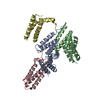
| ||||||||
|---|---|---|---|---|---|---|---|---|---|
| 1 | 
| ||||||||
| 2 | 
| ||||||||
| Unit cell |
|
- Components
Components
| #1: Protein | Mass: 15884.057 Da / Num. of mol.: 2 / Fragment: TPR Source method: isolated from a genetically manipulated source Source: (gene. exp.)  Homo sapiens (human) / Gene: CHIP, PP1131, STUB1 / Plasmid: pHis//2 / Production host: Homo sapiens (human) / Gene: CHIP, PP1131, STUB1 / Plasmid: pHis//2 / Production host:  References: UniProt: Q9UNE7, Ligases; Forming carbon-nitrogen bonds; Acid-amino-acid ligases (peptide synthases) #2: Protein | Mass: 11423.743 Da / Num. of mol.: 2 / Fragment: Lid-Tail (delta626-638) / Mutation: delta(626-638) deletion mutant Source method: isolated from a genetically manipulated source Source: (gene. exp.)  Homo sapiens (human) / Gene: HSC70, HSP73, HSPA10, HSPA8 / Plasmid: TOPO / Production host: Homo sapiens (human) / Gene: HSC70, HSP73, HSPA10, HSPA8 / Plasmid: TOPO / Production host:  #3: Water | ChemComp-HOH / | |
|---|
-Experimental details
-Experiment
| Experiment | Method:  X-RAY DIFFRACTION / Number of used crystals: 1 X-RAY DIFFRACTION / Number of used crystals: 1 |
|---|
- Sample preparation
Sample preparation
| Crystal | Density Matthews: 3.46 Å3/Da / Density % sol: 64.43 % |
|---|---|
| Crystal grow | Temperature: 293 K / Method: vapor diffusion, hanging drop / pH: 7 Details: 1.7M ammonium citrate, 0.1M HEPES, pH 7.0, VAPOR DIFFUSION, HANGING DROP, temperature 293K |
-Data collection
| Diffraction | Mean temperature: 100 K |
|---|---|
| Diffraction source | Source:  SYNCHROTRON / Site: SYNCHROTRON / Site:  ALS ALS  / Beamline: 4.2.2 / Wavelength: 1 / Beamline: 4.2.2 / Wavelength: 1 |
| Detector | Type: NOIR-1 / Detector: CCD / Date: Oct 17, 2012 |
| Radiation | Monochromator: Rosenbaum-Rock Si(111) sagitally focused monochromator Protocol: SINGLE WAVELENGTH / Monochromatic (M) / Laue (L): M / Scattering type: x-ray |
| Radiation wavelength | Wavelength: 1 Å / Relative weight: 1 |
| Reflection | Resolution: 2.91→64.75 Å / Num. obs: 17188 / % possible obs: 97.8 % / Observed criterion σ(F): 2 / Observed criterion σ(I): 2 |
| Reflection shell | Resolution: 2.91→3.01 Å / Redundancy: 12.1 % / Rmerge(I) obs: 0.639 / Mean I/σ(I) obs: 4.2 / % possible all: 76.7 |
- Processing
Processing
| Software |
| |||||||||||||||||||||||||||||||||||||||||||||||||||||||||||||||||||||||||||||||||||||||||||||||||||||||||||||||||||||||||||||||||||||||||||||||||||||||||||||||||
|---|---|---|---|---|---|---|---|---|---|---|---|---|---|---|---|---|---|---|---|---|---|---|---|---|---|---|---|---|---|---|---|---|---|---|---|---|---|---|---|---|---|---|---|---|---|---|---|---|---|---|---|---|---|---|---|---|---|---|---|---|---|---|---|---|---|---|---|---|---|---|---|---|---|---|---|---|---|---|---|---|---|---|---|---|---|---|---|---|---|---|---|---|---|---|---|---|---|---|---|---|---|---|---|---|---|---|---|---|---|---|---|---|---|---|---|---|---|---|---|---|---|---|---|---|---|---|---|---|---|---|---|---|---|---|---|---|---|---|---|---|---|---|---|---|---|---|---|---|---|---|---|---|---|---|---|---|---|---|---|---|---|---|
| Refinement | Method to determine structure:  MOLECULAR REPLACEMENT MOLECULAR REPLACEMENTStarting model: PDB ENTRIES 2C2L, 3LOF Resolution: 2.91→64.746 Å / SU ML: 0.41 / σ(F): 1.6 / Phase error: 24.54 / Stereochemistry target values: ML
| |||||||||||||||||||||||||||||||||||||||||||||||||||||||||||||||||||||||||||||||||||||||||||||||||||||||||||||||||||||||||||||||||||||||||||||||||||||||||||||||||
| Solvent computation | Shrinkage radii: 0.9 Å / VDW probe radii: 1.11 Å / Solvent model: FLAT BULK SOLVENT MODEL | |||||||||||||||||||||||||||||||||||||||||||||||||||||||||||||||||||||||||||||||||||||||||||||||||||||||||||||||||||||||||||||||||||||||||||||||||||||||||||||||||
| Refinement step | Cycle: LAST / Resolution: 2.91→64.746 Å
| |||||||||||||||||||||||||||||||||||||||||||||||||||||||||||||||||||||||||||||||||||||||||||||||||||||||||||||||||||||||||||||||||||||||||||||||||||||||||||||||||
| Refine LS restraints |
| |||||||||||||||||||||||||||||||||||||||||||||||||||||||||||||||||||||||||||||||||||||||||||||||||||||||||||||||||||||||||||||||||||||||||||||||||||||||||||||||||
| LS refinement shell |
|
 Movie
Movie Controller
Controller


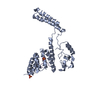


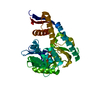


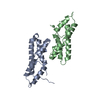
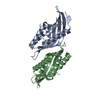

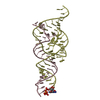


 PDBj
PDBj
























